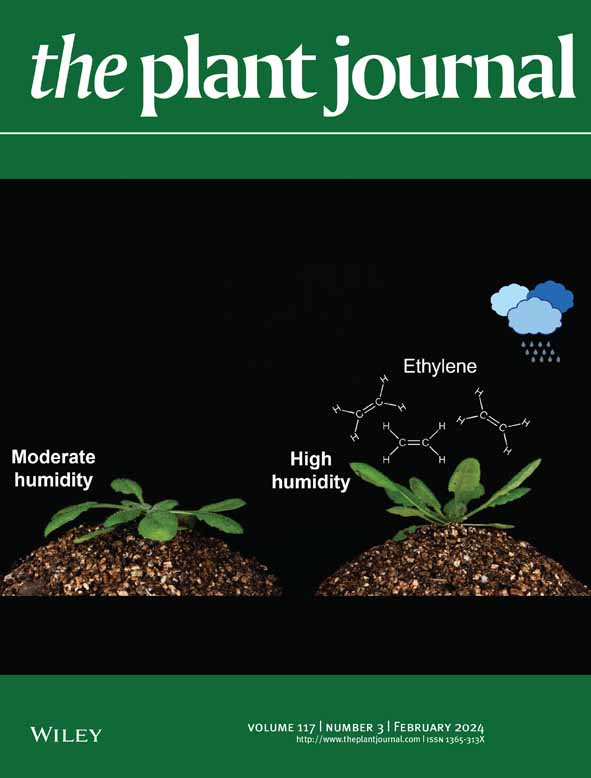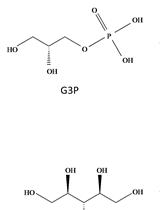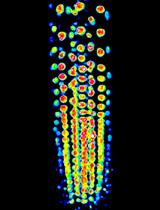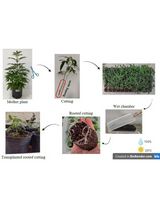- EN - English
- CN - 中文
A New Approach to Detect and Semi-quantify All Molecular Species and Classes of Anionic Phospholipids Simultaneously in Plant Samples
植物样本中阴离子磷脂所有分子种类与类别的同步检测及半定量新方法
发布: 2025年04月20日第15卷第8期 DOI: 10.21769/BioProtoc.5282 浏览次数: 1424
评审: Pooja VermaPooja SaxenaSamik Bhattacharya
Abstract
Membranes are very complex and dynamic structures that are essential for plant cellular functions and whose lipidic composition can be influenced by numerous factors. Anionic phospholipids, which include phosphatidylserine, phosphatidic acid, phosphatidylinositol, and phosphoinositides are key components of these membranes as they are involved in plant cell signaling and as even slight modifications in their quantities may largely impact the cell metabolism. However, the presence of these compounds in low amounts, as well as their poor stability during analysis by mass spectrometry, make their study very complicated. In addition, the precise quantification of all anionic phospholipid species is not possible by lipid separation using thin-layer chromatography followed by the analysis of their fatty acyl chains by gas chromatography. Here, we describe a straightforward strategy for the extraction and semi-quantification of all anionic phospholipid species from plant samples. Our method is based on the derivatization of the anionic phospholipids, and more especially on their methylation using trimethylsilyldiazomethane, followed by analysis by high-performance liquid chromatography coupled with a triple quadrupole mass spectrometer. This approach allows largely improving the sensitivity of the analysis of anionic phospholipids from plant samples, which will help to gain deeper insights into the functions and dynamics of these key parts of plant cellular signaling.
Key features
• Extraction, derivatization, and semi-quantification of anionic phospholipids (PA, PS, PI, PIPs) from plant samples.
• The methylation of anionic phospholipids using trimethylsilyldiazomethane largely improves their stability and therefore the sensitivity of the analysis.
• HPLC-QQQ-MS/MS analysis allows the semi-quantification of all methylated anionic phospholipids with high sensitivity.
• Allows to investigate the diversity and dynamics of anionics phospholipids in a wide range of plant samples (leaves, cultivated cells, membranes, …).
Keywords: Anionic phospholipids (阴离子磷脂)Background
Anionic phospholipids include phosphatidic acid (PA), phosphatidylserine (PS), and phosphatidylinositol (PI) species, as well as the phosphorylated form of the latter, namely monophosphate phosphoinositide (PIP) and bisphosphate phosphoinositide (PIP2) molecules in plants. These compounds form a structurally diversified class of membrane lipids since a high variety of fatty acyl chains can be found esterified in these different negatively charged phospholipids, making their analysis very challenging. However, anionic phospholipids display key functions in plant cells as they are components of the plasma membrane and are involved in a variety of cellular processes. Notably, anionic phospholipids are essential components of plant membrane signatures, allowing their recognition by specific enzymes; they can also modulate their physicochemical properties (such as charge and curvature) in response to environmental features. These lipids also play important roles in signal transmission as their accumulation is very dynamic and regulated by many enzymes; they can be quickly degraded or metabolized for the production of secondary messengers [1].
While mass spectrometry, through a direct infusion approach or in combination with liquid chromatography, is generally the method of choice for lipidomic analysis, the low abundance of anionic phospholipids as well as their poor stability and ionization efficiency during analysis increase the difficulty of their profiling and quantification, notably from plant samples. Indeed, sensitivity problems as well as low peak resolution are highlighted. For this reason, a multi-step approach is generally used for the analysis of anionic phospholipids by combining the separation of their different classes by preparative thin-layer chromatography and the analysis of their fatty acyl chains by gas chromatography. While this method allows us to understand the diversity in the fatty acyl chains of each class of anionic phospholipids, it does not give a comprehensive view of the diversity of anionic phospholipids in plant samples.
Based on the fact that methylation improves anionic lipid ionization efficiency, we developed a straightforward method for the extraction and semi-quantification of all classes of anionic phospholipids (Table S1) from plant samples by HPLC–MS/MS following their methylation using trimethylsilyldiazomethane [2]. Our results highlight not only the successful application of this method to a large set of plant samples (e.g., leaves, roots, purified membranes, and cultivated cells) but also the great improvement in the sensitivity of anionic phospholipids analyses in comparison with the same lipids analyzed without being methylated. Notably, methylation improved the wide peak shape and therefore enhanced the precision of the analysis. Our method therefore paves the way for the development of straightforward methods allowing the profiling and quantification of anionic phospholipids with high precision and sensitivity, not only from plant samples but also from other biological materials.
Materials and reagents
Biological materials
1. Plant material, dried or fresh: can be leaves, roots, or purified organelles
Reagents
1. MilliQ water (Elga, Purelab Flex)
2. Methanol (MeOH), LC-MS grade (Fisher, catalog number: M/4062/17)
3. Chloroform (CHCl3), analytical reagent grade (Fisher, catalog number: C/4960/17)
4. Hydrochloric acid 37% (HCl) (Sigma-Aldrich, catalog number: 258148)
5. Acetic acid (CH3COOH) (Sigma-Aldrich, catalog number: A6283)
6. Isopropanol (Sigma, catalog number: I9516)
7. Formic acid (Sigma, catalog number 33015)
8. Ammonium formate (NH4CO2) (Sigma, catalog number 70221)
8. 17:0-14:1 PI (Avanti Polar Lipids, catalog number: LM1504)
9. 15:0-18:1 PA (Avanti Polar Lipids, catalog number: 330721)
10. 17:0-14:1 PS (Avanti Polar Lipids, catalog number: LM1304)
11. 17:0-20:4 PIP (Avanti Polar Lipids, catalog number: LM1901)
12. 17:0-20:4 PIP2 (Avanti Polar Lipids, catalog number: LM1905)
13. Trimethylsilyldiazomethane 2M solution in hexane (TMS) (Thermo Scientific, catalog number: 385330250)
14. Nitrogen (N2) (Messer, 5.0)
Solutions
1. Extraction mix (see Recipes)
2. Pre-derivatization mix (see Recipes)
3. Post-derivatization mix (see Recipes)
4. Eluent A (see Recipes)
5. Eluent B (see Recipes)
Recipes
1. Extraction mix
| Reagent | Final concentration | Quantity or Volume |
|---|---|---|
| Methanol | n/a | 484 mL |
| Chloroform | n/a | 242 mL |
| HCl (1 M) | 32.1 mM | 24.2 mL |
| Total | n/a | 750.2 mL |
2. Pre-derivatization mix
| Reagent | Final concentration | Quantity or Volume |
|---|---|---|
| Methanol | n/a | 12 mL |
| Chloroform | n/a | 24 mL |
| HCl (0.01 M) | 2 mM | 9 mL |
| Total | n/a | 45 mL |
3. Post-derivatization mix
| Reagent | Final concentration | Quantity or Volume |
|---|---|---|
| Methanol | n/a | 12 mL |
| Chloroform | n/a | 24 mL |
| H2O | n/a | 9 mL |
| Total | n/a | 45 mL |
4. Eluent A
| Reagent | Final concentration | Quantity or Volume |
|---|---|---|
| Methanol | n/a | 400 mL |
| NH4CO2 50 mM in methanol | 10 mM | 200 mL |
| H2O | n/a | 400 mL |
| Formic acid | 26 mM | 1 mL |
| Total | n/a | 1,001 mL |
5. Eluent B
| Reagent | Final concentration | Quantity or Volume |
|---|---|---|
| Isopropanol | n/a | 800 mL |
| NH4CO2 50 mM in methanol | 10 mM | 200 mL |
| Formic acid | 26 mM | 1 mL |
| Total | n/a | 1,001 mL |
Laboratory supplies
1. Eppendorf tubes, 2 mL (Sarstedt, catalog number: 72.691)
2. Eppendorf tubes, 1.5 mL (Sarstedt, catalog number: 72.706)
3. Stainless steel beads, 5 mm (Qiagen, catalog number 69989)
4. 2 mL HPLC vials (Agilent, catalog number: 5182-0714)
5. 250 μL glass inserts (Agilent, catalog number: 5183-2085)
Equipment
1. Scientific balance, 0.1 mg precision (BEL Engineering, model: ULTRA MARK 210)
2. Cell lyser (QIAGEN, model: TissueLyser II)
3. Vortex Genie 2 (Scientific industries, model: G-560E)
4. Centrifuge operating at room temperature (Thermo Scientific, model: HERAEUS PICO 17)
5. Evaporator (Toutlemonde, model: T52B)
6. Ultrasonic bath (Advantage-lab, model: AL04-06)
7. Column Supelcosil ABZ PLUS C18 10 cm × 2.1 mm, 3 μm (Merck)
8. Ultra-high-performance liquid chromatography (Agilent, model: 1290 Infinity II LC system)
9. Mass spectrometer (Sciex, model: QTrap 6500)
Software and datasets
1. MultiQuant (Sciex, AB Sciex 3.0.3)
2. Analyst (Sciex, AB Sciex 1.6.2)
Procedure
文章信息
稿件历史记录
提交日期: Dec 13, 2024
接收日期: Mar 3, 2025
在线发布日期: Apr 3, 2025
出版日期: Apr 20, 2025
版权信息
© 2025 The Author(s); This is an open access article under the CC BY-NC license (https://creativecommons.org/licenses/by-nc/4.0/).
如何引用
Genva, M., Mirande-Bret, C. and Fouillen, L. (2025). A New Approach to Detect and Semi-quantify All Molecular Species and Classes of Anionic Phospholipids Simultaneously in Plant Samples. Bio-protocol 15(8): e5282. DOI: 10.21769/BioProtoc.5282.
分类
植物科学 > 植物生物化学 > 代谢物
生物化学 > 脂质 > 脂质测定
您对这篇实验方法有问题吗?
在此处发布您的问题,我们将邀请本文作者来回答。同时,我们会将您的问题发布到Bio-protocol Exchange,以便寻求社区成员的帮助。
提问指南
+ 问题描述
写下详细的问题描述,包括所有有助于他人回答您问题的信息(例如实验过程、条件和相关图像等)。
Share
Bluesky
X
Copy link












